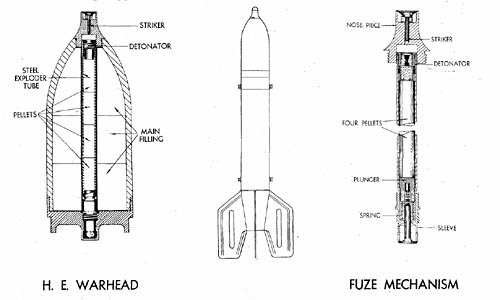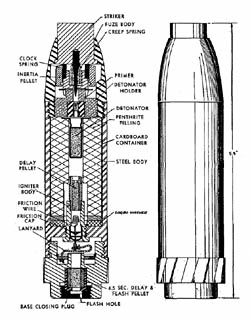
This rocket is actually 78 mm in diameter. Two features distinguish it from other German rockets: the use of tail fins to secure stability in flight without rotation, and the employment of a novel fuze arming device.
The complete round weighs 15.19 pounds and is nearly 28 inches long. Its two principal components are the nose fuzed high explosive war head and the rocket motor tube. The shell is attached by means of an adaptor ring and the motor tube is closed by a cone-shaped assembly carrying the fins and containing the venturi and propellant supporting grid. Six tubular sticks of cordite form the propellant ignited by a circular gun powder igniter set off by a wire ignition bridge. The launcher used is the Mantelrohr.
The nose fuze consists of a steel nose piece housing a light alloy striker held by a light spring, a percussion detonator, a magazine containing four pressed pellets, and a thermal arming device. When the rocket is fired, the heat of the propellant gases melts a ring of fusable metal, permitting the detonator and magazine to approach the striker. The main filling of the high explosive head is pressed flake TNT.
SPECIFICATIONS
| Weight of complete round | 15 lbs., 3 oz. | |
| Weight of motor unit with central adaptor | 10 lbs. | |
| Weight of high explosive head with central adaptor | 6 lbs., 5 oz. | |
| Weight of high explosive filling | 1 lb., 5 1/2 oz. | |
| Weight of fuze (approx.) | 4 oz. | |
| Weight of propellant sticks | 2 lbs., 3 oz. | |
| Length of rocket | 27.7 ins. | |
| Ground range (estimated) | 6,300 yds. |
German: p. 359 (May 1, 1945)
 This grenade consists of a tubular steel body containing an explosive filler of penthrite wax, a detonator, a direct action nose fuze, a delay friction igniter, and a base assembly containing a self-destroying system. A diaphragm near the bottom of the grenade is threaded centrally to receive the friction igniter. The fuze and base assemblies are not integral parts of the grenade, but are screwed into the nose and base respectively. If the nose fuze does not function properly, the grenade is self-destructive. On firing, the flash from the propelling cartridge enters a hole in the base closing plug and ignites a 6.5 second delay pellet contained in a brass holder. This fires the friction igniter which, gives an additional delay of 4.5 seconds before setting off the detonator. The grenade may also be used as a hand grenade by removing the base assembly and pulling a cord attached to the friction igniter.
This grenade consists of a tubular steel body containing an explosive filler of penthrite wax, a detonator, a direct action nose fuze, a delay friction igniter, and a base assembly containing a self-destroying system. A diaphragm near the bottom of the grenade is threaded centrally to receive the friction igniter. The fuze and base assemblies are not integral parts of the grenade, but are screwed into the nose and base respectively. If the nose fuze does not function properly, the grenade is self-destructive. On firing, the flash from the propelling cartridge enters a hole in the base closing plug and ignites a 6.5 second delay pellet contained in a brass holder. This fires the friction igniter which, gives an additional delay of 4.5 seconds before setting off the detonator. The grenade may also be used as a hand grenade by removing the base assembly and pulling a cord attached to the friction igniter.